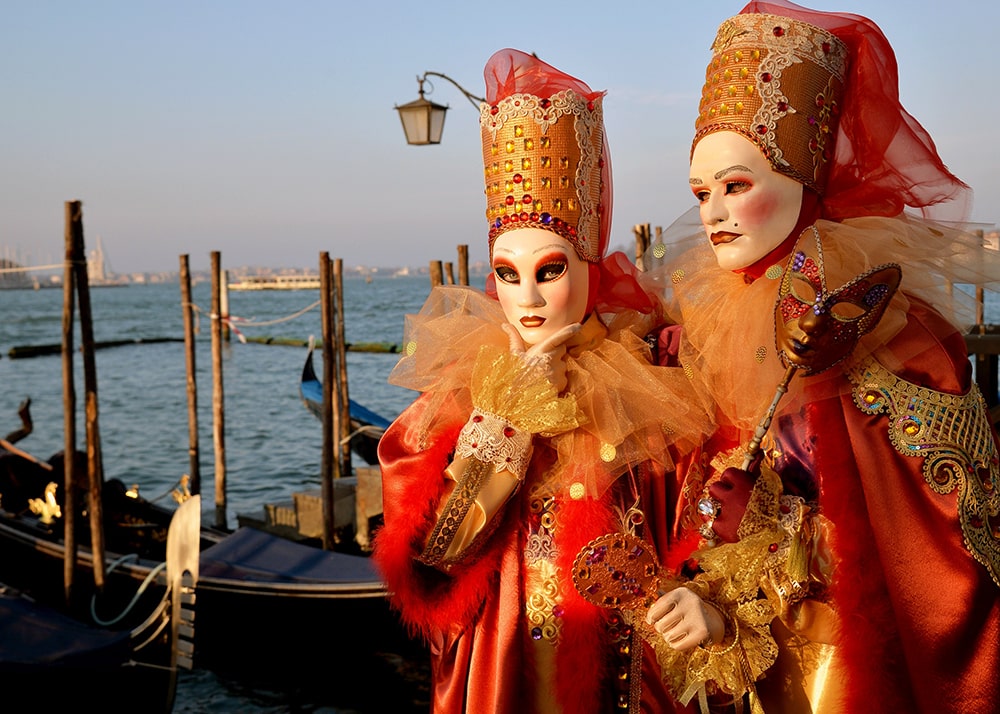Carnival season in Europe: heading towards unrestrained fun

If the New Year holidays lasted only a couple of days and you feel like you haven’t had enough rest and entertainment, there is a wonderful opportunity to immerse yourself once again in the atmosphere of fantastic fun. To do this, we recommend embarking on a journey to the famous carnivals of Europe.
The European carnival season begins in early February and is accompanied by vibrant costumes, dances and noisy parades. Street processions and parties become a grand event for locals and thousands of tourists from all over the world.
To hide behind a mysterious mask in Venice, catch a bouquet of fresh mimosa flowers in Nice or go to the ancient festival of Mohács in Hungary – carnival is a great opportunity to turn into someone else for a few days and have a great time!
Are your suitcases ready? Then it’s time to choose a destination to your liking and embark on an unforgettable journey!
Venetian Carnival, Italy
Every year about 500 thousand tourists from all over the world come to the carnival in Venice. It seems as if the famous parade has always taken place, but that’s not the case: from the late 18th century until the end of the 20th century, carnivals were prohibited. Only since 1979 have the authorities started supporting the celebration of this noisy holiday.
The Venetian Carnival takes place before the Catholic Lent, so the dates vary depending on the church holidays. This year, it will be held from January 27th to February 13th.
The first two days of the Venetian Carnival take place on the water. Colorfully decorated gondolas sail along the Cannaregio Canal and in the evening there is a laser show and a concert.
And what’s a carnival without masks and costumes? People not only stage theatrical performances in the costumes of past centuries but also walk around the streets in them. By the way, it’s not mandatory for tourists to dress up in carnival costumes, although some establishments may not let them in without one. The most popular characters of the Venetian Carnival are Harlequin, Columbine, Pantalone, Bauta and the Plague Doctor. So if you want to “fit in” with the festive procession, boldly choose one of these costumes!
Bohemian Carnival in Prague, Czech Republic
The Prague Bohemian Carnival is a period of feasting and merriment before the start of Lent. It is celebrated throughout the Czech Republic and locals call it ‘Masopust’, which means “meat fast”.
The festival takes place on the eve of Ash Wednesday (the first day of Lent) and in 2024 it will be held from February 8th to 14th. Some pre-carnival festivities begin at the end of January. But the most memorable and vibrant celebration on the city streets, known as the “Wild Merriment”, takes place on the day of the official opening of the carnival.
The Prague Carnival is a noisy and joyful holiday with balls, masquerades, street processions and theatrical shows. Traditionally, the carnival opens in the former royal residence of Klam-Gallas. Throughout the festival guests can enjoy concerts in the Old Town Square, masquerades for adults and children, gondola rides on the Vltava River and fashion shows.
The most spectacular performance is the Mask Gathering in front of the city hall, where the masked individuals on the Old Town Square put on performances. And the highlight of the event is the arrival of the Carnival King. During the festival representatives of the city hall officially hand over the powers to him.
Carnival in Binche, Belgium
The Carnival in Binche has been held since 1394 and is considered one of the oldest carnivals in Europe. It lasts only 3 days during which the men of the town dress up as Gilles, the main character of the carnival.
The first day of celebration always falls on a Sunday. On this day men put on red and black embroidered costumes, hats with feathers and bells and wooden clogs and take to the streets, dancing and singing to the accompaniment of barrel organs and drums.
The second day of the carnival is the Youth Festival. Representatives of various youth organizations parade through the streets of the city accompanied by a music parade. And on the last day of the carnival local residents and tourists gather in the main square of the city, dance, eat sweets and throw oranges at each other. In 2024, the carnival will take place from February 11th to 13th, but these three days will certainly be the brightest and most memorable for the residents and guests of the city.
Carnival in Madeira, Portugal
The Winter Carnival is the biggest celebration in Madeira. Like in other European countries, this carnival is a traditional festivity before the beginning of Lent.
This year the carnival will take place from February 7th to February 18th. On the first day of the celebration, musicians will take to the streets to awaken the residents with cheerful melodies. But the real fun will start on Sunday, February 11th, when a colorful carnival procession will go along the streets.
Another interesting and unforgettable moment of the celebration will be on Tuesday, February 13th. On this day a parody of the Sunday parade will take place. Comedians and actors in ridiculous costumes will mock the participants of the parade, entertain the audience and make funny faces. The celebration will end with a traditional fireworks display and noisy festivities that will last until dawn.
Carnival in Santa Cruz de Tenerife, Spain
Arguably the only carnival that can rival Rio de Janeiro’s carnival is the one in Santa Cruz. Around a million people visit the festival, which takes place on the island of Tenerife, every year.
This year the carnival will be held from February 7th to 18th, just before the start of Lent. The main character of the festival is the queen, who is traditionally chosen at the beginning of the show. The candidates perform before the jury in lavish costumes that can weigh hundreds of kilograms and cost tens of thousands of euros. The candidates are evaluated by representatives of local authorities and invited celebrities.
Once the queen is chosen, the carnival itself begins with costume parades, concerts, contests and a separate celebration for children.
The symbol of the end of the carnival is the burial of the sardine. During the ceremony, thousands of mourners, accompanied by representatives of the church, ghosts, and scarecrows, bid farewell to the dying festival. This happens in the form of a funeral procession. A giant cardboard sardine is carried through the city and then burned in the main square. Undoubtedly, this is the most amusing and characteristic element of the festival.
Of course, these are not all the carnivals in Europe. The carnival in Cologne, Germany, is also worth mentioning. It will take place from February 8th to 14th and each day of the celebration will be dedicated to a specific theme (Women’s Thursday, Procession of the Spirits on Saturday, Children’s Carnival on Sunday, and Rose Monday – the day when papier-mâché figures of world politicians are paraded through the streets of the city and sweets are handed out).
Another vibrant festival is the carnival in Nice, France, which has been held since the 13th century. The main events are the Float Parade and the Flower Parade. This year the carnival will take place from February 17th to March 3rd.
And, of course, there is the carnival in Lucerne, which will be held from February 8th to 13th. It has been celebrated since the 15th century and begins six days before Lent. The signal for the start of the celebration is a gunshot, after which concerts, processions, acrobatic and dance performances begin. The main costume parade starts on Monday and the carnival concludes with the Parade of Monsters, featuring torches, candles and music.
What to consider when going to a carnival in Europe
Carnival Europe is worth your attention. Visiting one of the bright festivals is definitely worth it at least once. And in order for the trip to leave only pleasant impressions, take a few simple tips into account:
- It’s better to stay in the city center, but it’s cheaper in the suburbs. You will only need a few days to visit the carnival. If possible, stay in the city center. This way you won’t waste time commuting and will be able to take a walk around the city early in the morning or late in the evening. However, prices will be much higher. So if you’re not ready for long trips on trains or subways, consider accommodation options in advance.
- Don’t make specific plans. Yes, you can pre-study carnival websites and choose the most interesting events for yourself. But keep in mind that you can easily be late for them due to traffic jams, crowds on the streets, and in the subway.
Book places in restaurants and cafes in advance. Even if it’s just a pizzeria, getting a spot won’t be easy. European cities during carnival season are overcrowded, so restaurants simply can’t accommodate everyone. - Bring a costume with you. It doesn’t matter what it will be. During the carnival the city is filled with various characters, so you will blend in naturally in the crowd. Having a costume also gives you the opportunity to attend the closing event, so don’t overlook this privilege.
- Be attentive. When in a large crowd of people, keep an eye on your belongings, and choose comfortable clothing and shoes.
- Buy a ticket in advance for one of the carnival balls. Carnival events are divided into free street celebrations and paid ones held in palaces and theaters. It’s better to purchase tickets in advance for the latter to ensure you get to the desired event for sure.
Planning a trip to carnival Europe
The carnival season in Europe will begin already at the end of January, which means it’s time to prepare for your trip.
The first thing you need to do is to apply for a Schengen visa. And it’s best to entrust this matter to the specialists at The Visa Services. Thanks to their experience and knowledge you will be able to obtain a Schengen visa in the shortest possible time. And even if you leave this issue until the last minute, you can confidently rely on our assistance in obtaining an urgent Schengen visa.
And while the specialists at The Visa Services will take care of your documents, you will have enough time to choose an interesting route and order a carnival costume for the most unforgettable trip of this winter!
FAQ:
Q: How long can I stay in the Schengen area with a visa?
A: The embassy has the right to set certain restrictions on the number of days of stay in Schengen countries depending on the type of visa and the purpose of the trip. But the maximum number of days of stay is 90 days every 6 months, starting from the date of entry.
Q: I have already visited many carnivals in Europe. Now I dream of visiting the carnival in Rio de Janeiro and in America. Can I use the services of The Visa Services to obtain a visa to these countries?
A: Our company helps to obtain visas to various countries in the world. We recommend submitting an application so that our manager can contact you and clarify the possibility and details of obtaining a visa to your desired destination.
Q: I want to visit multiple carnivals. Can I do this with a single visa?
A: Yes, a Schengen visa allows for free movement between countries in the Schengen area. But it’s better to make sure that your visa is not limited to the country where it was obtained at the consulate.



